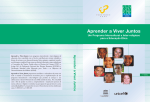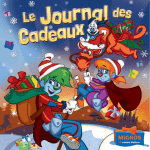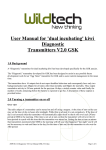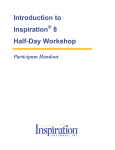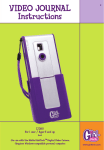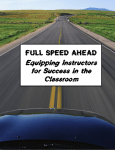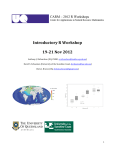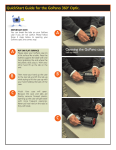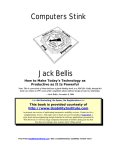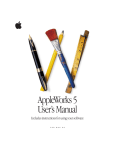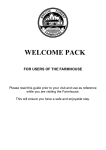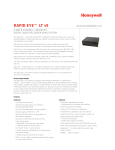Download TAKE A LOOK AROUND YOU
Transcript
Environmental Awareness To use creativity To use ICT To write texts TAKE A LOOK AROUND YOU Description of the task In this task, students create a poetry-photo album using a presentation application. The theme of this album is centered on some aspect of their physical environment outside the school. Students work individually and in small groups at the computer. Target group: adaptable to any level Duration: 4-6 classes Material: digital camera, presentation application (PowerPoint, AppleWorks Slide Show, Key Note, etc.), notepads to record thoughts. The task is presented here in AppleWorks Slide Show (see How to set up your poetry-photo album using AppleWorks Slide Show) and PowerPoint. Evaluation: Cross-Curricular Competencies To use creativity is targeted to see how well students express their ideas in new ways. The evaluation of the use of Information and communications technologies (ICT) in this task begins with the production of the slide show and focuses on the student’s ability to create a poem-photo page in the slide show. The means of evaluation for both competencies is a Teacher Evaluation Checklist. ESL Competencies To write texts is targeted to evaluate the student’s use of strategies. The means of evaluation is a Student Self-Evaluation Checklist. Preparation of the activity 1) During class time, take an observation walk around your school and have students bring small notepads to draw and take notes in. Bring along a digital camera so students can take photos. When you return to class, discuss the different topics you have come up with. 2) Select a topic that you found in your school’s environment. Pick something obvious that you see everyday but look at it in a new way. Here are some ideas: seasonal changes in a forest birds in your schoolyard trees planted by graduation classes footprints in the snow garbage in your schoolyard images that cracks in rocks make animals in your schoolyard trees in your schoolyard the school’s neighbours footprints in the mud the school at nighttime images that cloud formations make 3) Brainstorm with your students about what they felt, what they know, and what they need to know about their topic. This includes vocabulary. They may know that seagulls, for instance, eat dead animals and garbage, but they may not know the term “scavenger”. Draw a word web on the board with your topic in the centre. Write down everything you know and everything you want to know. Your students may need to do a little research to fill in the blanks. What is the name of the gull we see in our yard? Where does it go in the winter? likes to fight over food eats fish, garbage, anything! white, gray and black feathers TYPE FOOD DESCRIPTION Seagull greenish-yellow bill and legs black ring on bill white spots on black feathers MY FEELINGS HOME Home ENEMIES lives near water and its food other gulls and lack of food harm chicks; pollution noisy, Yuk!, cute, walks funny, eats too much junk, stays in groups, beautiful when it is flying, Cool! friendly Carrying out the activity Poetry is about feelings. A student’s response to a walk in the woods or seagulls flying in the schoolyard may not require any research. However, some students may need Internet time to look for information or vocabulary in order to write their poems. Activity 1 You may have already read poems, chanted nursery rhymes or sung songs in your class. If not, it is important that you expose your students to some poetry before you ask them to write poetry. The more you do, the better the results. See the Teacher’s Page for information and websites on different types of poems and how to write poetry in About Poetry. Activity 2 After reading and enjoying poems your students can model, attempt a collective poem on the board where each group in your class gets to invent a line. Here is a word cinquain example (see About Poetry for more information): Group 1 (chooses the topic) Group 2 (describe) Group 3 (action) Group 4 (feeling) Group 5 (another word for topic) Seagulls Noisy, screaming Fight over food Invade our recess fun Scavengers Activity 3 Next have students write their own poems. Include the stages of first draft, self and peer revision, and final copy. Assimilation/Transfer of learning Have students reflect on the strategies they used to get their ideas, to find the vocabulary they needed to express their ideas, and to structure their poems. Students then complete the Student Self-Evaluation Checklist. Encourage your students to experiment with different poetry forms using topics of their choice. Each student is now responsible for creating a page in the slide show. This involves selecting a photo or photos as a background, selecting type font and size for the poem, and planning the general layout of the slide. How to set up your poetry-photo album using AppleWorks Slide Show Reference: AppleWorks 5 User’s Manual Step 1 Download the photos from your digital camera into a file on your computer. Step 2 To create slides, you first have to open a document. If you open a draw document, for instance (the easiest to do), each page in your document will become one slide. Select the number of pages (slides) you plan to create under Document. Step 3 Enter the information you want on each page. For the poetry-photo album, students will copy and paste photos taken with the digital camera and type their poems onto the photos they have selected to accompany their poems. Step 4 Once all the slides on the pages of your document have been created, you can set up the slide show, determine in what order you want the slides to appear, and choose visual effects such as fading, looping, or advancing at a set number of seconds. To choose these effects, click Slide Show from the Window menu. In the Slide Show dialog box, choose the options you want and then click Done. Step 5 In the Slide Show dialog box, you can change the order of your slides by simply dragging the page number (slide number) to where you want it to be. Step 6 Now it’s time to present. Click Slide Show in the Window menu and then click Start. Your presentation is saved as a draw document but uses the Slide Show application to present it. One word of advice: When pasting a photo onto an entire page as a background, make sure it is no bigger than the page; if it is any bigger than the page, it will bleed onto the next page. You can check for this by previewing your slide show. Teacher’s Page Evaluation criteria and means The teacher evaluates the originality of the poem and its presentation in the application using the Teacher Evaluation Checklist. Students evaluate their use of strategies during the process of poetry writing by using the Student Self-Evaluation Checklist. Evaluation criteria evaluated by teacher To use creativity To use ICT Originality of connections among the elements Effective use of computer tools Evaluation criterion evaluated by student To write texts Use of strategies When projecting the poetry-photo album to your class, you may wish to have your students recite their poems or, if time permits, have students read and record their poems into the presentation. Pronunciation of their poems can then also be evaluated. Present your album to a wider audience during open-house night, teacher-parent conferencing, school assemblies, or in the front lobby showcasing students’ work. Play it on a monitor or use a multimedia projector. About Poetry Poetry is a writing form that is seldom explored in the second language classroom. It has rhythm and sometimes rhyme; it is easy to write; it has few rules and allows children to express themselves in a new way. You may want to guide your students’ writing by chosing one of the following poetry forms: Couplet – a two-line poem or two-line stanza that usually rhymes. I look at the tree The tree looks at me Its leaves wave goodbye As they float to the sky Haiku – a three-line poem usually about nature with a set number of syllables per line (5-7-5). Go easy on the syllables for ESL students. The oak tree looks bored No leaves blow in its branches It waits for springtime Word cinquain – Line 1: the subject in 1 word Line 2: describe the subject in 2 words Line 3: express the subject in action in 3 words Line 4: express a feeling about the subject in 4 words Line 5: another word for the subject (See “Seagulls”) Acrostic poem – Write the subject vertically. Each letter of the word begins the first word of each line. Shiny and hot Umbrella of warmth Need it to live Concrete poem – This poem takes the shape of what the poem is talking about. A very tall tree stops my skin from burning in this scorching sunlight. Sh ad e. For more information on the different types of poems and how to write poetry, visit the following websites: Giggle poetry www.gigglepoetry.com How to write funny poetry www.poetry4kids.com/howto.html How to write poems (via Teacher Zone) www.poetryzone.ndirect.co.uk/index2.htm How to teach poetry – Poetry theater – Poetry activities www.poetryteachers.com Poetry plus www.trib.com/~johnbn/poetry/teach.htm Forms of poetry falcon.jmu.edu/~ramseyil/poeform.htm (Type in address) Ideas for writing poetry in the classroom www.netaxs.com/~katz/teachers.htm E-muse – 15 poems you can write now www.poetryexpress.org Children’s Corner – An Anthology of Children’s Poems www.geocities.com/Heartland/Hills/3678/children.htm The Mother Goose Pages www-personal.umich.edu/~pfa/dreamhouse/nursery/rhymes.html (Type in address) Student Self-Evaluation Checklist Name: ____________________________ Check (√) one or more boxes. I am good at: asking for help in English using what I know about the topic doing research, looking for information following models provided by the teacher Next time, to improve, I have to: know what I am supposed to do pay attention and concentrate on the right things take risks by using new vocabulary practice (try and try again) Comments: __________________________________________________ __________________________________________________ __________________________________________________ __________________________________________________ __________________________________________________ Teacher Evaluation Checklist Class ___________ Student’s name Legend: 1 – Excellent Is receptive to trying to express ideas in a new way 2 – Good Demonstrates originality in his/her poem 3 – Need to improve Makes effective use of computer throughout production









